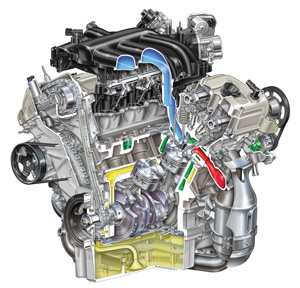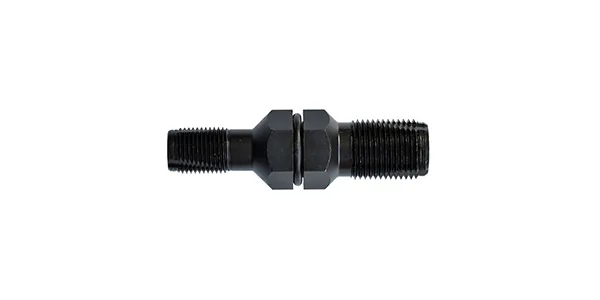Next, you do the same procedure for the right cam. But first, you need to rotate the crankshaft 120° clockwise so the crankshaft keyway is at the 3 o’clock position. Mark the right timing chain and install it the same as before.
Once both chains are in place, remove the locking pin or paper clip from the left and right chain tensioners.
Rotate the crankshaft 120° counterclockwise so the keyway is back at the 11 o’clock position and number one piston is at TDC. Check to make sure all the timing marks are aligned as shown in the illustration on page 26.
There should be 12 chain links between the right and left intake and exhaust cam sprocket marks, 27 chain links between the cam gears and crank on the non-tensioned side of each chain, and 30 links between the cam gears and crank on the tensioned side of each chain.
Driveability Issues
If the check engine light is on and you find a code P1518, it means the intake manifold runner control (IMRC) system has a problem. Most likely, the runner control is stuck in the open position. Sludge can build up in the IMRC causing it to stick. Ford also offers a PCM reprogramming fix in TSB 02-15-3 that causes the IMRC to cycle at speeds over 40 mph so sludge doesn’t build up on the runner plates.
If you run into an engine in a 1996-’98 Taurus or Sable that cranks and has spark, but won’t start, the fault may be a dead fuel pump because of shorted wiring. TSB 98-25-1 covers the installation of protective plastic tubing on the fuel pump wires to prevent chaffing on these vehicles.
Hard starting and long cranking times on 1996-’98 Taurus and Sable may be caused by bad fuel, wet spark plug wires or a sticking idle air control valve. TSB 98-21-12 covers the diagnosis of this condition, and TSB 97-9-5 covers replacing the IAC valve.
P0171 and P0174 lean codes are common faults on many Ford, including the 3.0L Duratec. The lean fuel condition is often caused by a dirty mass airflow sensor, vacuum leaks in the intake manifold or vacuum connections, or a defective DPFE sensor. The fix may require cleaning or replacing the MAF sensor, or using a smoke machine to find elusive vacuum leaks in the intake plumbing.
If you find a 1996-2003 Taurus or Sable with a rolling idle or surge problem, poor fuel economy, or codes P1336, P1309 or P0340, the cause may be a misaligned camshaft position sensor. TSB 02-22-1 covers diagnosis of the cam sensor and aligning the cam sensor with a special installation tool.

Cooling System Service
One common problem we’ve seen in high-mileage Taurus/Sable vehicles with the Duratec engine is coolant contamination caused by rust and corrosion in the coolant pipes that snake around the engine. This is often the result of coolant neglect. Cleaning and flushing the system can get rid of the gunk, but it won’t stop the corrosion inside the steel pipes. Replacing the pipes is recommended to halt the rusting problem.
Electrolysis that eats through the heater core also can be caused by missing, loose or broken engine ground straps. You can use a voltmeter to check for electrolysis in the coolant. Remove both cables from the battery, then touch the negative test lead to the negative battery post, and the positive lead to the coolant in the radiator or coolant reservoir.
A reading of more than 0.4 volts indicates trouble. Check the engine ground straps. Ford says not to ground the heater core as this will make the electrolysis problem worse. Be sure to drain and refill the cooling system with new coolant.













